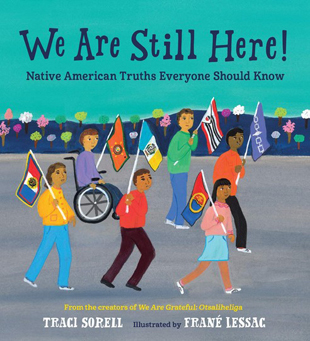When Traci Sorell was growing up, she was never given the opportunity to read culturally accurate books about the ways of her Cherokee ancestors or any other Indigenous peoples. In keeping with her mission "to add to the canon of literature showing that Native Nations and their citizens still exist and thrive today," as her website describes it, she offers We Are Still Here.
Designed for children ages 7 to 10, the book conveys what has happened to Native Nations since treaty making stopped in 1871. It starts by drawing us into the Indigenous Peoples' Day presentations of twelve Native American students from various tribes. This format gives room for a dozen brief yet powerful explorations of laws and policies including Assimilation, the Indian New Deal, Tribal Activism, Self-Determination, Religious Freedom, Language Revival, and Sovereign Resurgence.
The section on Allotment, for example, describes how even after Native Nations gave up large pieces of land in treaties, the U.S. Congress passed the General Allotment Act, which divided Native lands into individual plots and gave the "leftover" land to white settlers and railroad companies. Frané Lessac, who did extensive research to create this book's illustrations, portrays a mother and son sitting on the doorstep of a log home, looking out with uncertainty as a train rolls by on tracks dividing the landscape not far behind them.
The book remains honest and clear about such injustices, but the overall refrain is one of celebration and triumph:
"In spite of all this, Native Nations say,
'We are still here!' "
Courage and resilience pours through the pages as Native citizens speak and act to recover lands and languages, attend to healthcare needs, restore terminated tribes to federally recognized status, reclaim the right to practice their beliefs and ceremonies, increase educational opportunities, and in many other ways overcome oppression and exercise tribal sovereignty.
The story concludes with a colorful, detailed, double-page illustration of children, parents, and teachers gathered at the Indigenous People's Day Presentation Night. More information about each of the topics and their illustrations follows. A timeline, glossary of terms, list of sources, and author's note draw this bounty of information and insight to a close. In her note, Sorell writes:
"With more than 570 tribes inside US borders today, the histories of individual Native Nations' experiences with federal laws and policies also deserve to be known. Whether or not you are a citizen of a Native Nation, I encourage you to research whose ancestral lands you live on and how specific tribes have experienced — and still experience — the laws, policies, and movements included in this book." For this suggested further research, Sorell and Lessac have laid the groundwork impeccably.
